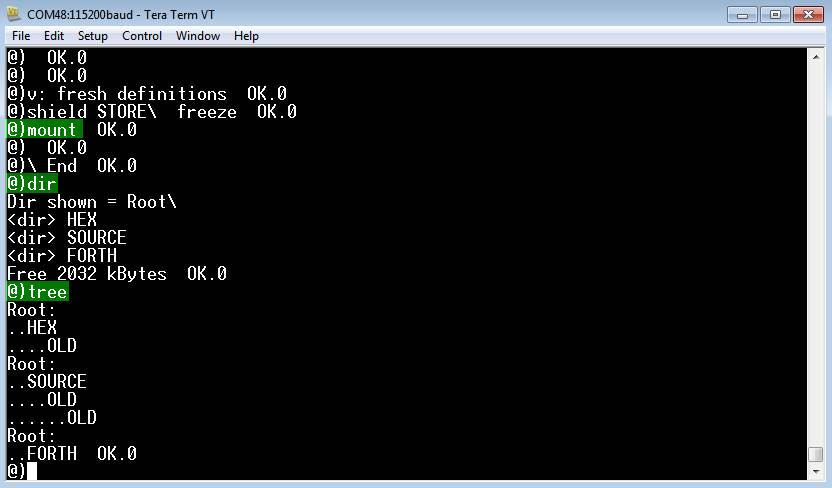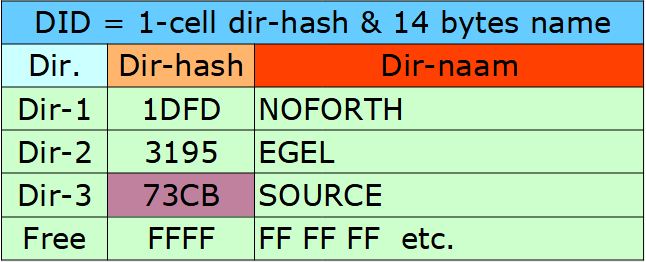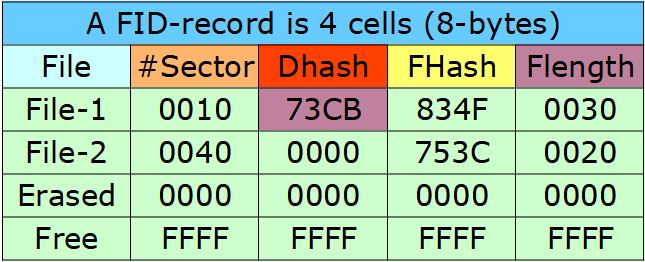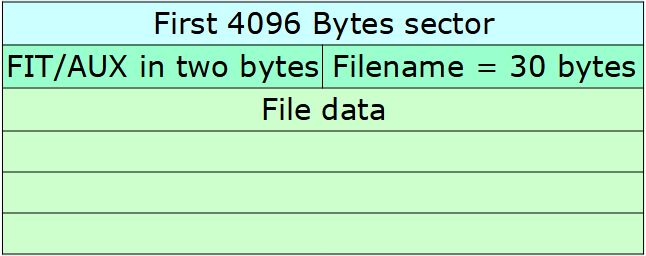Table of Contents
NOF file system, for small Flash chips
NOF idea
Read and store data from/to source files on some sort of background medium.
For these purposes a file system could be used.
There are lots of variants present: FAT16, FAT32, NTFS, Ext2, Etc.
This design is about a compact file system for small controllers and Flash memory chips.
It uses 16-bit CRC-codes instead of file names and directory names.
NOF was developed on top of noForth and stands for nOForth File system.
It can ofcourse be used on any system with limited resources.
NOF structure
- The reading is done on a per-byte basis
- Write goes in 256-byte sectors
- Erasure is done with sectors of 4096 bytes, or … the entire chip at once
- The first 4096 bytes is the
FET(File Entry Table) - The
FETsector contains theFID(File ID) &DID(Directory ID) - A file has a size of 4096 bytes or a multiple of that
- Each file-ID is 8-bytes, a directory-ID is 16-bytes
- The first 32 bytes of a file contains the file name,
FIT(FIle Type) and an auxillary byte
A 2-Mbyte Flash has 512 pages of 4096 bytes.
When the first sector is used for the FET, 511 pages are free for files.
The FID gets 3072 bytes, the DID the remaining 1024 bytes.
This means there is space for 384 files and 64 directories.
When you are in need for more files and directories, just take the first two or more (erase)-sectors
of the Flash chip for administration.
File ID record
2 Bytes 2 Bytes 2 Bytes 2 Bytes (8 bytes)
----------------------------------------------------------
| sector number | dir hash | filename hash | file length | ( max. 384 files )
Directory ID record
2 Bytes 2 Bytes 12 bytes (16 bytes)
-------------------------------------------------
| Dir-hash | Working-Dir-hash | Dir-name string | ( max. 64 directories )
File header & first file record
Byte Byte 30 bytes 4064 or more bytes
|-------------------------------| --------------------- |
| FIT | Aux | Filename 30 bytes | File data |
NOF basic implementation parts
- An SPI-driver & setup for the Flash chip
- Operating commands for the Flash chip (Write, Read, Erase, etc.)
- Some tools (
FDUMPdump flash memory) - Multiple file buffers
- Directory stack
MOUNTfunction- Convert a string to 16-bits CRC
- Choose & show directory
- Find file & include file
- Write, Read & Erase given sectors
- Build
FIDentry & file name block
Later on some more additions, like:
- Store ASCII files
- File viewer
- Remove files, wipe complete disk
- Make directory and a directory
TREEfunction
Pseudo code for the NOF SPI layer
More detailed info on SPI all numbers in hexadecimal (SPI protocol, general introduction)
Function: FSPI-OUT ( b -- ) \ Output a byte using the SPI-bus
Function: FSPI-IN ( -- b ) \ Read a byte from the SPI-bus
Function: FSPI-SETUP ( +f -- ) \ Initialise SPI-bus to Flash with frequency +f
Function: {FL ( b -- ) \ Enable Flash access & send first byte
Function: FL} ( -- ) \ Close Flash access
Function: {FREAD ( a c -- b )
{fl split 32bit into two 16bit hi part on top fspi-out
split 16bit into two 8bit part hi part on top fspi-out
fspi-out fspi-in
Function: FREADY? ( -- f )
5 {fl spi-in fl} 1 and 0=
Function: WRITE-ON ( -- ) 6 {fl fl}
Function: BUSY ( -- ) begin fready? until
Function: CHIP-ERASE ( -- ) write-on 60 {fl fl} busy
Function: POWER-UP ( -- ) 66 {fl 99 fspi-out fl}
Function: FC@ ( a -- b ) 3 {fread fl}
Function: FC@+ ( a -- a+1 b ) dup 1 + swap fc@
Function: F@ ( a -- x ) 3 {fread fspi-in fl} make 16-bit
Function: F@+ ( a -- a+2 x ) dup 2 + swap F@
Function: FTYPE ( a u -- ) 0 ?DO fc@+ emit LOOP drop
Function: ID. ( -- ) 0 90 {fread fspi-in fl} . .
Save number base & set it to decimal
Function: FDUMP ( a u -- )
<freq> fspi-setup power-up
0 ?DO new line and print address followed by ':'
show 10 bytes from flash memory in hexadecimal
show 10 bytes as ASCII or a space when not a valid character
Add 10 to address
Stop when a key was pressed
LOOP drop address
Pseudo code for the NOF structure layer
Function: RWDATA ( A data structure of 7 cells for the NOF structure layer )
Function: !DATA ( x +n -- ) Store x op position +n in RWDATA
Function: @DATA ( +n -- x ) Read x from position +n in RWDATA
0000 value #SECTOR ( Flash sector counter, initialised by MOUNT )
0000 value BUF ( Buffer in use 0/1 )
0000 value #N ( Byte index in sector buffer )
200000 100 / constant #FLASH ( Minimal flash size, max: 1000000 )
0000 constant #FID ( Begin address of file ID block )
0C00 constant #DID ( Begin address of directory ID block )
1000 constant #FILES ( Begin of file area )
Function: INIT-RWDATA ( -- )
Write flag is zero, collected data is zero,
store zero in #n and select buffer-0
Function: 'NAME and reserve 20 bytes for string to convert
create DID and reserve 0C bytes RAM after it
value DPT ( Directory nesting pointer )
value 'DID ( Free directory space pointer )
value 'FID ( Free file index pointer )
value HASH> ( Hash working space )
Function: .DFREE ( -- )
Save number base & set it to decimal
Subtract #SECTOR from #FLASH and divide by 4
to convert from sectors to kBytes, print it & restore base
Function: ROOT ( -- ) 0 did h! 0 to dpt
Function: DID> ( -- ) dpt IF did dup 2 + swap dpt move DPT = DPT + 2 THEN
Function: $>UPC ( a1 u -- a2 u )
Store string a1 u1 at 'name, save length
Convert string in 'name to uppercase
leave address of converted string & length
Function: IHASH ( h -- ) Store h in HASH>
Function: >HASH ( c -- ) Read HASH> xor char c do result times 2 and store in HASH>
Function: HASH ( a u h0 -- h1 ) Generate file hash h1 from given string a u & hash seed h0
Function: DHASH ( 'did h0 -- h1 ) Generate dir hash h1 from string stored in 'did+2 & hash seed h0
value FADDR
Function: FKEY ( -- c )
faddr fc@ increase faddr ?dup ?exit -2 to source-id 0D ;
Function: MOUNT ( -- )
<freq> fspi-setup initialise R/W data structure
Token of FKEY to alternative KEY-vector
Initialise 'FID by scanning the FID memory until FFFF is found
Initialise 'DID by scanning the DID memory until FFFF is found
Initialise first free file sector from reading the last found file entry
store it in #SECTOR finally set directory to the root
Pseudo code for the NOF directory mechanism
Function: CHECK-DHASH ( h -- f )
Save current DIR-entry address
#did 'did over - bounds DO ( Loop true directory space )
dup i f@ = IF ( Is there a hash match? )
replace dir-entry address
Leave true and leave loop immediately
THEN
10 +LOOP ( To next DIR-entry )
drop false ( No directory found )
Function: .DIR ( did -- )
When did is zero its the root show that ans ready
check-dhash IF
Read dir-entry address and print it's name
THEN
Function: .PATH ( -- )
Get DID read DPT pointer and print
the current directory nesting in correct order
Function: >DHASH ( a u -- h1 h0 )
Limit string to 0E characters ( 00 to 0D )
Generate root hash value h0 and current DIR hash value h1, leave both
Function: CHOOSE-DIR ( a u -- )
>dhash was it a backslash then select ROOT
Is it a dot then go back one directory nesting when possible
check-dhash and abort when it's an invalid directory
Otherwise extend directory nesting and save current DIR record address
Function: CD ( "dir" -- )
Set a new directory nesting by unraveling the given string by parsing it with
backslashes. When there is a backslash in front start in the root.
When the string is done, show the new directory path using .PATH
Function: .FIT ( +n -- )
Print file type +n as an ASCII string, +n comes from the 20 bytes file header
Function: DIR ( -- )
1) Print current dir path with .PATH
2) Read current directory entry from DID and print all
sub)directories in it by calculating the nested hash with DHASH
Print the directory names that give a valid hash code
3) Now print the files names, by checking if it's dir-hash code is the
same as the one stored in DID if so print the file type and the name
from the 20 bytes file header
4) Finally show the free space on the Flash disk using .DFREE
Pseudo code for the NOF file search function
Function: CHECK-FHASH ( h -- f )
#fid 'fid bounds ?DO ( Setup search range )
Read dir hash value from second cell in FID entry
is it equal to the contents of DID
IF Read the the file hash from the third cell
when equal, save this FID record
leave true and were ready
THEN
THEN
8 +LOOP ( To next FID entry )
file hash not found, leave false
Function: >FHASH ( a u -- h )
Limit string to 1D chars, do: $>upc DID h@ dhash
Function: 'SEEK? ( a u -- sector true | false )
>fhash check-fhash IF
Read the files start sector, leave true & ready
THEN print "File not found" & leave false
Function: LOADFILE ( a -- )
source-id greater then zero, nest file address pointer
nest source-id and store a to faddr
set source-id to 1
call interpreter, when done
unnest source-id
when source-id is greater then zero unnest faddr & save
Function: SEEK ( "name" -- sector )
read blank delimited string "name"
'seek? issue error message when result was zero
Function: INCLUDE ( "name" -- ) immediate word
abort when used in a definition
read blank delimited string "name"
check if it's a forth file ans issue an error message when not
Calculate the files address & call: loadfile
Function: FILE ( "name" -- a ) immediate word
seek convert sector to file address
and compile it as a literal
Pseudocode for creating a file header
Create: 'SECTOR 200 allot ( -- a ) ( Reserve RAM for two sectors )
Define: ADDR-SECTOR ( sa -- )
split sa in low- & high-byte fspi-out fspi-out 0 fspi-out
Define: BUFFER ( +b -- a )
1 and 100 * 'sector +
Define: READ-SECTOR ( sa +b -- )
>r 3 {fl addr-sector r> buffer
100 0 do fspi-in over c! 1 + loop fl} drop
Define: WRITE-SECTOR ( sa +b -- )
>r write-on 2 {fl addr-sector r> buffer
100 0 do count fspi-out loop drop fl} busy
Define: ERASE-SECTOR ( sa -- )
write-on 20 {fl addr-sector fl} busy
Define: B, ( b -- )
#n 100 = IF set buffer full flag, select next buffer and clear #n THEN
store b in current buffer & increase pointer #n
Define: WR-BUFFER ( -- )
Write buffer-0 to #sector and increase #sector
Define: <WRITE> ( -- )
When buffer overflow has occured do: wr-buffer
and clear buffer full flag, copy buffer overflow
from buffer-1 to buffer-0, slect buffer-0 again
Define: !FLENGTH ( -- ) ( Patch current rounded file length in last FID record )
Read last used sector, round it to next 10th sector
Read current part of FID sector to buffer-1
Patch calculated file length into it
Write buffer-1 back to current FID sector
Define: FILE-NAME ( #fit a u -- )
init-rwdata limit string to 1D ans make uppercase
Calculate & check file hash value, abort when the hash value is not unique
Calculate, save & read current FID-sector in buffer-0
Save address of new FID record too
Store DID in record, after that the file-hash
Now write FID sector back & add 8 to 'FID
Now store file type on address 0 in buffer-0
after that the (limited) file name string
Set #n to 20 and ready
Define: ADD-FID ( #fit "name" -- )
Read next word from input stream and build a new file entry with it
NOF files
The added NOF example files are for noForth R on the GD32VF103, especially the seeed board which has a W25Q64 (8 Mbyte) Flash chip added on the board!
| File name | Purpose | in Dropbox (external link) |
| SPI Flash-03.f | NOF SPI layer | SPI Flash-03.f |
| NOF-3i.f | NOF base file | NOF-3i.f |
| NOF-write-1.f | NOF write | NOF-write-1.f |
| NOF-additions-1.f | NOF additions | NOF-additions-1.f |




